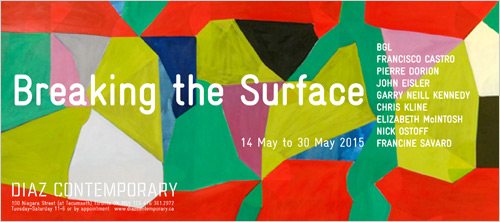


|
14 May to 30 May 2015
Opening Thursday 14 May from 6 to 9 pm
Breaking the Surface
BGL, Francisco Castro, Pierre Dorion, John Eisler, Garry Neill Kennedy, Chris Kline, Elizabeth McIntosh, Nick Ostoff, Francine Savard


While abstraction is liberated from the obligation to communicate recognizable imagery, it is presented with the same initial challenge, to make a mark. In some instances, the mark gives way to a division into sections, effectively breaking the surface, sometimes into a matrix of repeated gestures. With the suggestion of a geometry, we instinctively insert ourselves spatially, the non-objective transmuting to a bodily subjective. Each of the works in this exhibition pursues a modulation of surface, and whether restrained in gesture or complex in structure, exerts that sense of a spatial geometry and privileges the proximity of the human form.
For seasoned conceptualist Garry Neill Kennedy, the act of breaking the surface is embodied in a series of process-driven strategies: first, the division into four quadrants representative of its title, The Four Seasons; then into an index of seasonally evocative paint colour names; and finally in articulating the material matrix of the work’s chipboard support. With the work of BGL, a more organic approach is employed as the surface is fractured with cutout bits of misshapen fleshly vinyl, announcing a network of black lines from the underlying support, devising the structure alluded in the title, Vieille peau. In the case of Francine Savard, the division occurs first as a delineation between layers, as a textual fragment embedded in the expanse of a red monochrome asserts the canvas’s prior blankness, perpetually cleaving a gap between paint and canvas. She continues the idea of division with her title: 7,104 pouces carrés de rouge (7,104 square inches of red), which prompts the imagined overlay of a square-inch grid. Similarly, the breaking of the surface for Chris Kline is oriented in distinguishing between layers, demonstrated largely in transparency with his Dividers series, as one can peer through the delicately colour-stained, stretched poplin to the crossbars and frame of the supporting stretcher, a simultaneous enfolding and distinction of plane. Elizabeth McIntosh’s Animal Rhyme engenders both a rhythmic repetition and a rupture of form through overpainting and colliding patterns. The intense chromatic play, with a sustained gaze, reveals a complex series of subordinate structures. John Eisler’s Untitled works present as a series of physical folds and seams on monochromatic greycanvases, but the smooth, stretched surface belies that possibility, calling to mind perhaps a trompe l’oeil approach, but instead, here, the surface is broken in proxy, by applying an extraneous paint-soaked textile, folded and crumpled, to inscribe its network of creases into the recipient surface. The works of Pierre Dorion, Nick Ostoff and Francisco Castro emerge from a more pictorially intact perspective, but abstraction through the various devices of magnification, reduction or dislodged order refute their representational underpinnings. Pierre Dorion’s Zwirner II continues his exploration of architectural details moved to the point of almost pure abstraction, where a referred quality of light and reflection breaks the surface into restrained and luminous interstices, creating a depth just outside our ability to spatially decipher. For Nick Ostoff, the breaking of the surface is reduced to a schema of almost imperceptible evidence in the trace, with the division of the canvas occurring on one hand with the loose, linear partitioning of the marks, but almost more definitively by their insistent suspension above the pale, grey ground. Francisco Castro departs from representation just at its periphery, hovering between a formal abstraction and a document of a tiled floor’s worn and memory-laden surface with Displacement White/Black. The articulation of an unsettled grid of squares, further disrupted by an intensely worked surface, proposes abstraction while at the same time permits, even encourages, its reading as a kind of temporal record, allegiant to its source subject.
—Claire Christie
 
|
|
![]()